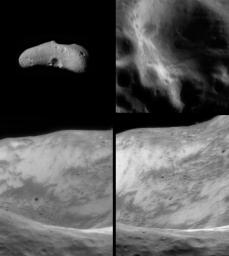As NEAR Shoemaker has descended to lower orbits around Eros and returned higher spatial resolution pictures, knowledge of surface landforms has grown dramatically. The effect of changing spatial resolution can be illustrated by comparing these pictures of the large, 5.3-kilometer (3.3-mile) diameter crater taken at different distances above the surface. All of the views are shown with north to the top.
The upper left picture, taken February 12, 2000, from 1,682 kilometers (1,045 miles) above the crater, shows the feature's outline with several smaller craters superimposed on its southern section. There are only hints of bright materials on the north wall of the crater. The upper right view, taken April 2 from 193 kilometers (120 miles) above the crater, provides 8.7 times higher spatial resolution. The change in appearance is dramatic; details in the craters on the south rim are clearly visible and the patterns in brightness variation on the north wall are easily discerned. However, there are only the vaguest hints of boulders on the surface.
The picture at lower left was taken June 14 from 44 kilometers (27 miles) above the crater, and the picture at lower right was taken July 19 from 32 kilometers (20 miles) above the crater. These views provide 4.4 and 6times higher spatial resolution than in the view at upper right. Again, the increase in spatial resolution reveals a new level of detail. Boulders have become easily visible, as have fine, dark streaks pointed downslope within the bright material. Variations in brightness also appear at even smaller spatial scales than could be seen before.
When NEAR Shoemaker flies to within 5.3 kilometers (3 miles) of Eros' surface on October 26, spatial resolution will increase by another 4 to 6times compared to the two lower views shown here. A whole new level of detail in the shapes of rocks and patterns of brightness variation will be visible - and features not yet seen at all may be revealed.
Built and managed by The Johns Hopkins University Applied Physics Laboratory, Laurel, Maryland, NEAR was the first spacecraft launched in NASA's Discovery Program of low-cost, small-scale planetary missions. See the NEAR web page at http://near.jhuapl.edu/ for more details.

 Planetary Data System
Planetary Data System












